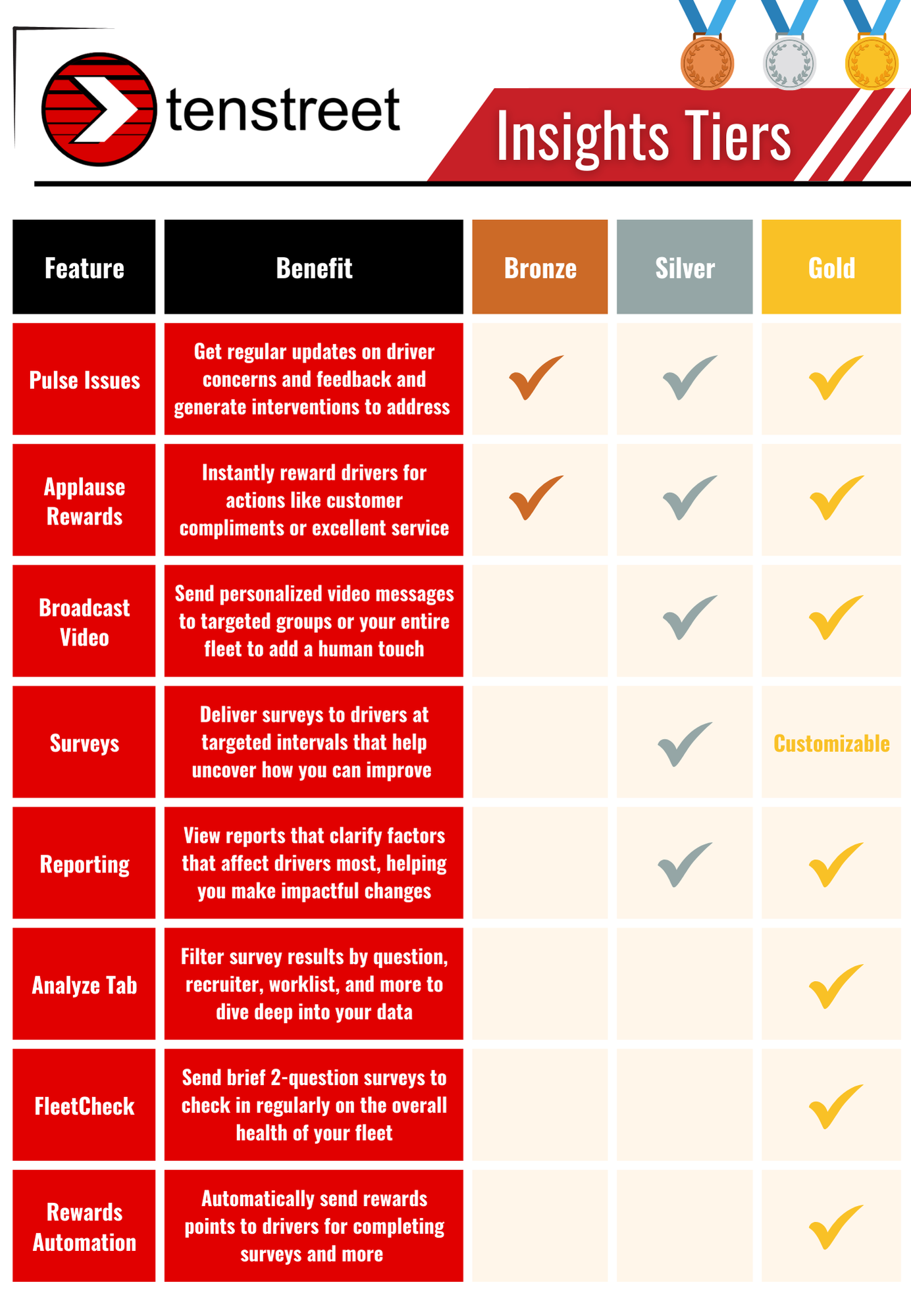KEEP DRIVERS IN YOUR SEATS
Take the guesswork out of driver retention with data-driven engagement solutions that deliver.
Stay on top of driver satisfaction with direct feedback from our powerful survey program.
Keep hires engaged with rewards programs, sweepstakes, and friendly competitions.
Increase driver retention by as much as 37% with tools designed to end turnover.
Trusted by the best

Insight
• Retain talent longer with a clear and consistent way of measuring driver experience
• Reach drivers with targeted surveys at every stage of their employment
• Using detailed analytics, identify areas for improvement and track results

Intervention
• Automatically flag dissatisfied drivers for engagement based on survey responses
• Surface issues that require immediate attention with weekly surveys
• Receive summary reporting to better understand common problem areas

Incentives
• Encourage driver success with gamified challenges, leaderboards, and rewards programs
• Automatically award points for performance touchstones like fuel efficiency and accident-free miles
• Delight drivers with points that can be redeemed for rewards they love, like popular gift cards

Insight
- Retain talent longer with a clear and consistent way of measuring driver experience
- Reach drivers with targeted surveys at every stage of their employment
- Using detailed analytics, identify areas for improvement and track results

Intervention
- Automatically flag dissatisfied drivers for engagement based on survey responses
- Surface issues that require immediate attention with weekly surveys
- Receive summary reporting to better understand common problem areas

Incentives
- Encourage driver success with gamified challenges, leaderboards, and rewards programs
- Automatically award points for performance touchstones like fuel efficiency and accident-free miles
- Delight drivers with points that can be redeemed for rewards they love, like popular gift cards

How Tenstreet's Digital Tools Improve Retention Rates
Targeted, customizable Insights surveys and analytics empower you to tackle driver turnover head-on and make impactful changes that boost retention.
Weekly check-ins through FleetCheck make drivers feel heard and enable carriers to gauge the temperature of their workforce so they can mitigate trouble fast.
Our flexible, efficient Rewards Program allows you to recognize driver achievements automatically with points that boost morale and retention.
Gamify engagement with fun goal-oriented challenges, leaderboard contests, and sweepstakes that keep drivers interested and performing at their best.
Develop deeper relationships with your drivers through video. Use Pulse Video Chat and Broadcast to communicate individually or fleet-wide.
TRUCK DRIVER RETENTION FAQS
Truck driver retention is one of the leading issues throughout the trucking industry. Understanding why truck drivers quit and what carriers can do about it means searching for creative truck driver shortage solutions.
Retention rates in trucking are consistently low, meaning carriers need to recruit, train, and integrate brand-new drivers into their fleets at an unprecedented pace. A lack of driver engagement is often seen as the root of the problem, but driver retention issues extend much further than that.
Companies must fully understand the driver retention meaning and work to understand why their drivers are leaving. Addressing these problems through comprehensive driver retention programs can alleviate these issues and improve the rate at which truck drivers remain with your organization, which saves your organization money in the long run.
Why do truck drivers quit, and what do those reasons mean for driver retention in the trucking industry?
Driver retention is always one of the top issues for carriers. Better management will lead to superior retention, and understanding why drivers quit is essential.
First, the trucking industry has suffered poor retention rates for decades. In 2019, turnover rates stood at a staggering 91%, with blame placed on poor pay and conditions.
However, there’s an important caveat to turnover. Unlike other industries, the American trucking industry does not necessarily see commercial drivers leaving the business when they quit. Job hopping has always been rampant.
Thousands of truckers have been forced out of the industry and off the road, but this is a short-term problem. It does not explain the lack of engagement or the industry’s fondness for job-hopping. Addressing the core reasons why drivers leave is the key to reducing turnover rates.
Truck drivers quit both their employers and the industry for several reasons. While the news may focus on one issue, there are often many causes for a driver’s departure.
Much of the training content and technology available to carriers targeted at retention helps them to get inside the minds of their workforce. Here are a few of the issues that we hear often.
Poor Pay
The top complaint from most drivers? Pay. Getting enough miles to justify the long hours and time spent away from home always plays on a trucker’s mind. Offering competitive rates is the first step to securing drivers for the long haul.
Employers must keep up with what competitors in the industry are willing to pay – if a driver could earn more from working for someone else, he will likely leave for that opportunity. Offering competitive pay is step one to improving driver retention rates.
Lack of Home Time
Truckers may spend weeks away from their families at a stretch. Lack of home time has always been a common complaint from drivers, yet it’s only one part of the problem. Unpredictability is another issue.
Drivers have lives, and if their downtime is unpredictable, it makes it difficult to make plans with their loved ones and show up for important moments.
Explore ways to offer more predictability and consistency when you’re first recruiting. Think about your hiring area and freight density when planning routes to ensure you get your drivers home regularly.
Breakdown in Relationships
Truckers work alone on the highway. Their most important contact is their dispatcher or fleet manager. Ensuring good relations with this primary contact point is vital to keeping your drivers happy.
You need fleet managers and dispatchers who knows how to listen to drivers. With so many freight jobs available, drivers will not hesitate to move on if they find themselves at odds with their primary point of contact within the company.
Unhappiness with Unpaid Downtime
Dispatching and scheduling are common pain points for drivers. Perhaps the most common complaint of all is unpaid wait time when making a delivery.
Slow unloading times mean your driver is waiting around and not getting paid. Using the right management software lets you study average loading/unloading times and know how to handle route planning. Efficiency at both ends is critical for good driver retention.
Trucking Industry is Not What it Seems
Unfortunately, drivers often find themselves unprepared or ill-informed regarding what life is like as a professional truck driver. Developing your own recruitment program that reveals the realities of the business and how it works can stop newbies from being pushed out the door within a few months.
Boosting driver retention is something you can get started on today. By using data-driven approaches like Tenstreet’s engagement tools to uncover points of contention throughout your business, you can address significant issues before they begin to cause dissatisfaction among your drivers.
As you’re getting started with putting a retention program in place, keep the following driver retention strategies in mind:
- Offer Value – Value goes beyond money. Do you listen to your drivers? Are you giving them enough time off? Will you provide them with opportunities for advancement? Does your organization offer any workplace benefits?
- Cultivate Collaboration – Drivers hate not being listened to. Build an organization that creates those two-way relationships. Ask for feedback from your drivers and take action based on those replies.
- Prioritize Health and Safety – Truck driving is one of the country’s most dangerous jobs. Make health and safety a priority through regular vehicle maintenance and training programs.
- Recognize Great Work – Make your drivers feel valued by recognizing exceptional performance. Bonuses, extra time off, or simply calling out a high-performing driver are all useful for creating a workplace where everyone feels like they matter.
- Emphasize Work–Life Balance – Long, lonely hours mark the trucking business. Emphasize work-life balance by giving drivers the flexibility they need to take some much-deserved time away. You might also want to think about company wellness programs.
Read Tenstreet’s blog on improving driver retention.

